Everyday Mathematics Grade K Answer Key Unit 6 Section 6
Everyday Math Grade K Home Link 6.1 Answer Key
Reading the Calendar
Family Note
Calendars offer valuable opportunities for children to count and read numbers. We have a calendar routine at school to help us keep track of school events. Have your child help you record and track important family appointments and events on a calendar at home.
Look at your calendar to find answers to the following
questions:
- How many days are in this month?
- How many Wednesdays? Fridays? Sundays?
- Are there more Wednesdays or Fridays? Weekdays or weekend days?
- What is today’s date?
- How many days are left in this month?
- Are there holidays or special days this month? When are they? Circle or mark them on your calendar.
- Does this month or last month have more days? How many more? How about next month?
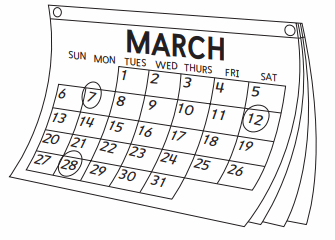
Answer:
- Number of days in this march month = 31 days .
- Number of Wednesdays in this march month = 5 or Five.
- Number of Fridays in this march month = 4 or Four.
- Number of Sundays in this march month = 4 or Four.
- There are more Wednesdays in this march month. Week days.
- Today’s date is 29 March.
- Number of days left out in this month = 2 or Two
- Yes, there are special days in this month.
Amlaki Ekadashi – March 25. …
Pradosh Vrat – March 26. …
Holika Dahan or Choti Holi and Vasanta Purnima – March 28. …
Chaitanya Mahaprabhu Jayanti – March 28. …
Lakshmi Jayanti and Panguni Uthiram – March 28. …
Holi – March 29….
Holi Bhai Dooj – March 30.

- This march month has 2 or Two more days than the February last month and April next month.
Explanation:

Number of days in this march month = 31 days .
Number of Wednesdays in this march month = 5 or Five.
Number of Fridays in this march month = 4 or Four.
Number of Sundays in this march month = 4 or Four.
There are more Wednesdays in this march month. Week days.
Today’s date is 29 March.
Number of days left out in this month = 2 or Two
Yes, there are special days in this month.
- Amlaki Ekadashi – March 25. …
- Pradosh Vrat – March 26. …
- Holika Dahan or Choti Holi and Vasanta Purnima – March 28. …
- Chaitanya Mahaprabhu Jayanti – March 28. …
- Lakshmi Jayanti and Panguni Uthiram – March 28. …
- Holi – March 29….
- Holi Bhai Dooj – March 30.

This month has 2 or Two more days than the last month and next month.
Everyday Math Grade K Home Link 6.2 Answer Key
Comparing Heights
Family Note
Your child is developing an understanding of measurement by comparing and ordering objects of different sizes from shortest to longest. Build on classroom experiences at home by helping your child record the heights of family members on a doorframe or a large sheet of paper. Measure and mark the same people’s heights again in a few months and note whether anyone has grown taller.
Have a family member measure and mark your height. Label it with your initials and the date.
Help measure, mark, and label the heights of other family members.
Compare heights:
Who is tallest?
Who is shortest?
Which family members are closest in height?
Line up your family members in order from shortest to tallest.
Mark and label everyone’s heights again in a few months and compare them with today’s heights.
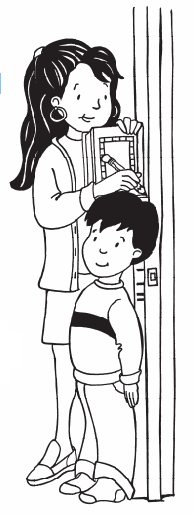
Answer:
My Daddy’s height = 70 inches.
My Mommy’s height = 66 inches.
My First younger brother height = 73 inches.
My Second younger brother height = 74 inches.
My Sister’s height = 68 inches.
My Height = 64 inches.
Compare heights:
My Second younger brother is the tallest.
I am the shortest.
My Second younger brother and First younger brother are closest in height.
Me, My Mommy, My sister , My Daddy , My First younger brother , My Second younger brother.
After three months, heights were checked of my family members yet there was no change in the heights.
Explanation:
My family has six members. My Daddy , My mommy , My Two little brothers , My sister and me.
My Daddy’s height = 70 inches.
My Mommy’s height = 66 inches.
My First younger brother height = 73 inches.
My Second younger brother height = 74 inches.
My Sister’s height = 68 inches.
My Height = 64 inches.
Compare heights:
My Second younger brother is the tallest.
I am the shortest.
My Second younger brother and First younger brother are closest in height.
Me, My Mommy, My sister , My Daddy , My First younger brother , My Second younger brother.
After three months, heights were checked of my family members yet there was no change in the heights.
Everyday Math Grade K Home Link 6.4 Answer Key
Solid-Shapes Museum
Family Note
At school we have been learning about 2-dimensional and 3-dimensional shapes, and children have been noticing shapes all around them. Manipulating, exploring, and discussing 3-dimensional objects helps children learn the names of these objects and builds their spatial sense. Many familiar objects closely resemble 3-dimensional geometric shapes. For example, balls are spheres and dice are cubes. At home, encourage your child to look for and describe 3-dimensional objects to bring to school for our classroom’s Solid-Shapes Museum. It is also helpful for children to notice and discuss the 2-dimensional shapes that are part of many 3-dimensional objects, such as the circular faces on the ends of cans and the square faces on dice.
Look around your home for 3-dimensional geometric shapes. Try to find examples like the ones below and describe them to someone.
sphere: ball, globe
cube: dice, square box
cylinder: food can
cone: ice-cream cone, party hat
rectangular prism: cereal box, book
Bring in some objects to add to our classroom’s
Solid-Shapes Museum.
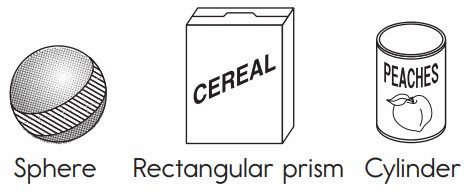
Answer:
Solid-Shapes Museum.
Sphere: Marble , Oranges , Christmas bauble.
Cube: Table top , Cube blocks
Cylinder: Batteries, Dustbins, Cylinder.
Cone: Vector traffic cone , Cone shaped glass.
Rectangular prism: Treasure box , Tissue box.
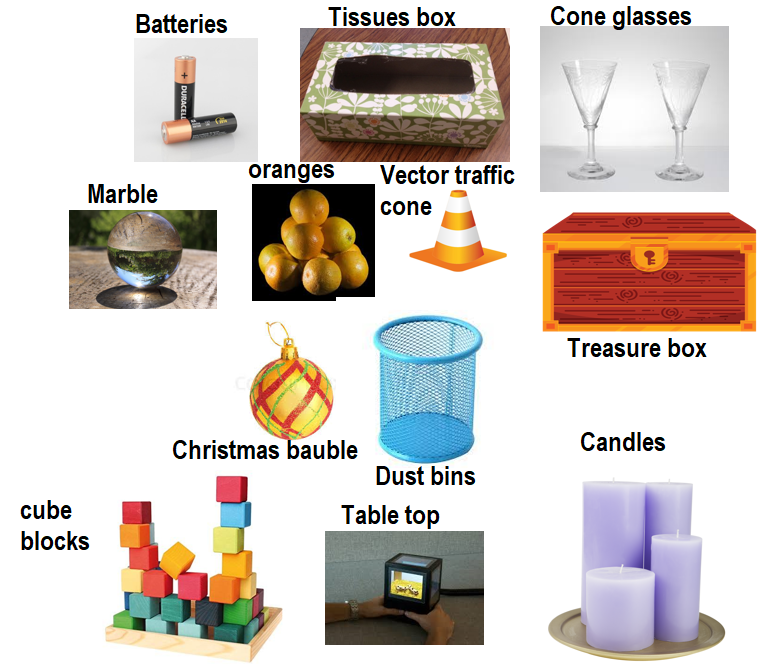
Explanation:
Solid-Shapes Museum.
Sphere: Marble , Oranges , Christmas bauble.
Cube: Table top , Cube blocks
Cylinder: Batteries, Dustbins , Candles.
Cone: Vector traffic cone , Cone shaped glass.
Rectangular prism: Treasure box , Tissue box.

Everyday Math Grade K Home Link 6.8 Answer Key
Take-Away Number Stories
Family Note
Your child has been learning about the subtraction (or minus) symbol. Share stories that involve taking away, or removing, groups of objects to help your child connect the subtraction symbol to real-world contexts.
Cut out the subtraction symbol (–).
Take turns telling and solving number stories that use subtraction. For example: We made 6 pancakes. Our family ate 4 of them. How many pancakes do we have left?
Use pennies or other small objects and the subtraction symbol (–) to act out, or model, the stories.
Draw or write one of your number stories below.

Answer:
There are five oranges in the home. Out of them, two oranges got spoiled. How many oranges are remaining not spoiled in the home?
Total number of oranges in the home = 5 or Five.
Number of oranges got spoiled in the home = 2 or Two.
Number of remaining oranges in the home = 5 – 2 = 3 or Three.

Explanation:
There are five oranges in the home. Out of them, two oranges got spoiled. How many oranges are remaining not spoiled in the home?
Total number of oranges in the home = 5 or Five.
Number of oranges got spoiled in the home = 2 or Two.
Number of remaining oranges in the home = Total number of oranges in the home – Number of oranges got spoiled in the home
= 5 – 2
= 3 or Three.

Everyday Math Grade K Home Link 6.9 Answer Key
Disappearing Snack Trains
Family Note
Your child has been learning to model “take-away” (subtraction) problems with real objects. For this activity, take all the aces, 2s, and 3s from a deck of cards and shuffle them. Or make 1, 2, and 3 number cards—four cards for each number—out of paper. Your child can help you find or make the cards.
Make two lines of 20 pieces of small snacks, such as fish crackers, cereal, or raisins—a line for you and a line for your partner.
Cut out the subtraction symbols (-) and place them to the right of each snack line.
Players take turns drawing a number card, laying it to the right of their subtraction symbol, and subtracting (eating) that number from their “snack train.”
After each turn, compare the trains:
Which has more snacks? Which has fewer?
Play until one player has eaten all their snacks. Shuffle and reuse the cards if you run out.

Answer:
I am having 20 Fish crackers.
My friend is having 20 Raisins.
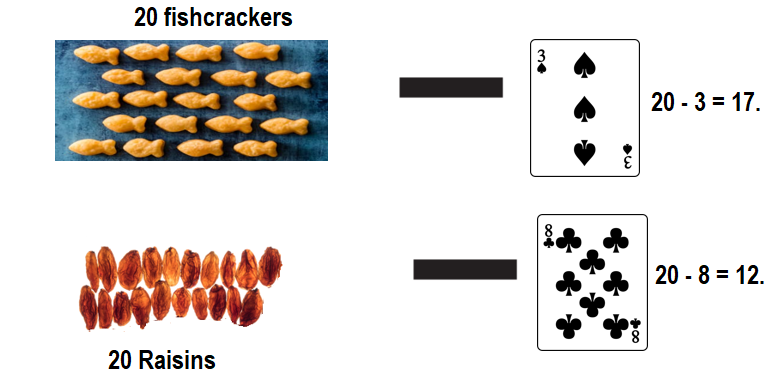
I have more Fish crackers than my friend has raisins.

I have more Fish crackers than my friend has raisins.

I have more Fish crackers than my friend has raisins.
Explanation:
I am having 20 Fish crackers.
My friend is having 20 Raisins.
First card:
I took number 3 card.
MY friend took 8 number card.

I have more Fish crackers than my friend has raisins.
Second card :
I took 8 Number card.
My friend took 6 number card.

I have more Fish crackers than my friend has raisins.
Third card :
I took 3 Number card.
My friend took 6 number card.

I have more Fish crackers than my friend has raisins.
Everyday Math Grade K Home Link 6.11 Answer Key
Penny Plate
Family Note
Play Penny Plate to help your child practice finding combinations of numbers that add to 10.
Materials 10 pennies, 1 paper plate
Players 2
Object To figure out how many pennies are hidden
Directions
1. Player 1 turns the plate upside down, hides some of the pennies under the plate, and puts the rest of the pennies on top of the plate.
2. Player 2 counts the pennies on top of the plate and figures out how many pennies are hidden under the plate.
3. Players trade roles and repeat Steps 1 and 2.
4. Play several rounds.
Play Penny Plate with a family member. What do you notice about combinations of numbers that add to 10?
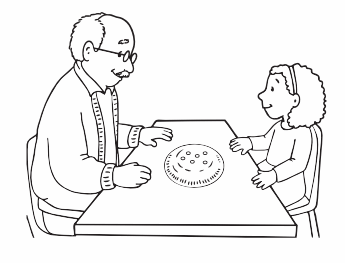
Answer:
Play Penny Plate with a family member.
I was playing this game with my grandfather.
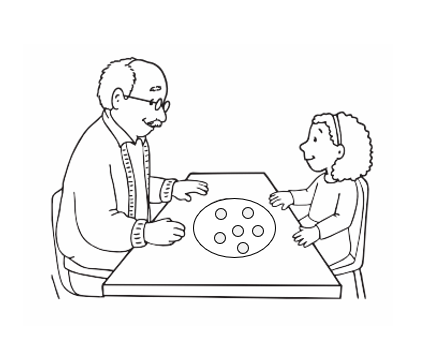
Total number of pennies = 10 or Ten.
Number of pennies on the plate = 6 or Six.
Number of pennies under the plate = 10 – 6 = 4 or Four.
Explanation:
Play Penny Plate with a family member.
I was playing this game with my grandfather.
Total number of pennies = 10 or Ten.
Number of pennies on the plate = 6 or Six.
Number of pennies under the plate = Total number of pennies – Number of pennies on the plate
= 10 – 6
= 4 or Four.
